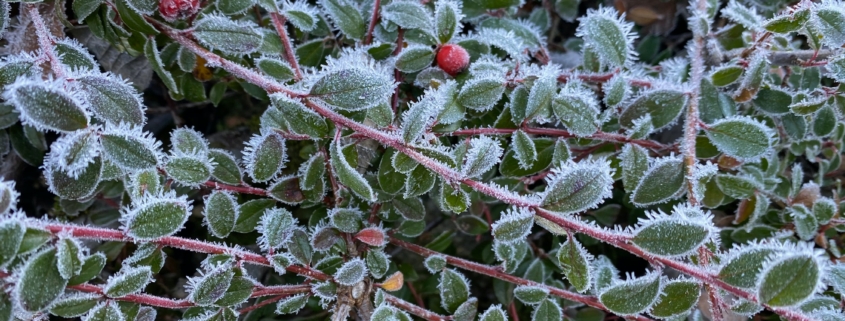Protecting Your Plants from an Early Frost
We all know winter is coming… Every. Single. Year. Yet it still manages to catch us off guard most of the time! Whether it is a sudden cold snap or an early snowfall, we often cross the line between crisp and downright cold overnight. And when we wake up, we see that thin layer of icy crystals over our lawns and all of the late season flowers and vegetables we weren’t quite ready to say goodbye to yet. Not to worry: there are several ways to protect your plants from an early frost.
It’s Coming! Protect Your Plants from an Early Frost
In Indianapolis, the first frost tends to fall towards the end of October. Foliage is past its peak, and the days are getting shorter and colder. Just a week ago — just a day ago — that would have been dew. Because of the decreasing temperatures, though, the water vapor freezes. We are not into killing frosts or freezes yet, but it’s a sure sign that those are coming.
Frost kills plants by freezing the water inside their cells; this causes them to expand, burst, and die. It’s a natural process — but that doesn’t mean we can’t take a little preventative action to prolong the life of our plants:
Keep An Eye on the Weather Forecast
As someone who loves your landscape, watching the forecast is probably part of your routine! If not, just take a peak at this time of year. Conditions that indicate a frost are clear nights with no cloud cover for insulation, as well as little to no wind. Many forecasts will also include a frost warning, so pay heed, and take action. Information is one of the best ways to protect your plants from an early frost.
Know Which Plants Are Vulnerable
By this time, your summer and early fall plants have gone by; you want to protect the late season plants and vegetables. Several varieties are hardy up to very low temperatures. It is important to know when to cover up. The Farmer’s Almanac has been a useful guide for centuries, and it can give the usual temperatures at which plants are vulnerable. For instance, your kale can survive at temps of 27℉ – 29℉. Should you still cover them in a frost? As we like to say, better safe than sorry!
Bring Potted Plants Inside
This is easy enough. If you have potted plants, hanging baskets, or container gardens that are easily transported, take them in around dusk. These plants are more vulnerable to frost damage because they don’t have the insulation from the ground to help warm them. You don’t want to put them in an area that is too warm, though, because the change in temperature is too much of a shock. The garage, mudroom, shed, or basement will do the trick beautifully.
After the frost dissipates, you can put them back outside to enjoy some daylight conditions. Oftentimes, early frosts give way to warmer weather again. Take advantage of this!
Give Them a Good Afternoon Watering
But… wont’ the water freeze them all the faster? It seems a bit backwards but watering your plants in the warmer midafternoon moistens the soil. This allows it to radiate heat up into the plants when it gets colder at night.
Now, if you didn’t get around to watering during the warmer part of the day, do not do it once the temperature starts falling. This will only make frost conditions worse on your plants. If you miss your window, there are other steps you can take to prevent damage.
Apply a Thick Layer of Mulch
It’s sweater weather. Instead of cotton or wool, your plants prefer wood chips, leaf mold, or even a big pile of leaves. If a frost is coming, apply a three-to-six-inch layer of mulching material, making sure to leave an inch or two opening around the central stalk of the plant. This enables warmth from the ground to radiate up from the plant, while the surrounding mulch adds protection. If the weather warms the next day (and we’re betting it will), clear away a bit of the cover.
Tuck Them in for the Night
When it comes down to it, our plants are just like us: they want to be warm and cozy during these late fall nights. One way to protect a larger group of plants (like your late season vegetable patch or decorative kale and cabbage) is to cover it with a bed sheet, blanket, or drop clothes. Basically, anything you have handy!
You want to create a tent-like effect, so install several stakes (or even just sturdy wooden sticks) around your plants, so the protective material lays on top of them. Let the material simply drape over the plants to the soil line; this enables heat from the ground to travel up to the plants.
If you’re really worried about a good hard frost, you can add an old shower curtain, plastic painter’s sheets, or tarp over the top of the fabric. The plastic should not touch the plants at all as it can damage them. Just weigh them down with a few stones or bricks to keep the layers from blowing away, and then remove the covering right away in the morning.
Another way to keep your plants warm is to cover them with a cloche. This is a small, translucent, bell-shaped covering designed to protect individual plants. You can buy gardening cloches, which are usually made of plastic, or you can improvise. Invert a bucket or flowerpot over the plant or cut the bottom off a plastic milk jug and situate it into the ground. DIY and done!
Put protective “blankets” and/or cloches in place in the early evening, and again, remove them in the morning.
Wrap Up Your Young Trees
If you have young trees (i.e., between one and four years), an early frost can injure or even kill them. Use blankets, towels, rags, burlap, or special felt tree protector wraps to wrap their trunks when there is a frost in the forecast. Start at the base, and then wind the material up and around until you reach the lowest branches. Secure the material with twine or some waterproof tape.
Enjoy — and Prepare For — the Season
Winter creeps up on us (Every. Single. Year!). You have a lot to do to get ready, whether it’s having your heating system cleaned and inspected or getting your snow gear out and your skis waxed. Leave the landscape to us. Entrusting late fall lawn and garden care to professionals gives you back your time and energy, so you can enjoy the season.
GreenImage can not only help you plan and execute the perfect landscape that takes you seamlessly from season to season, but we can assist you in maintaining your outdoor space, so it brings you pride and pleasure all year long.
Contact GreenImage to learn more about late fall and winter landscape maintenance. And let’s look forward to spring together!



